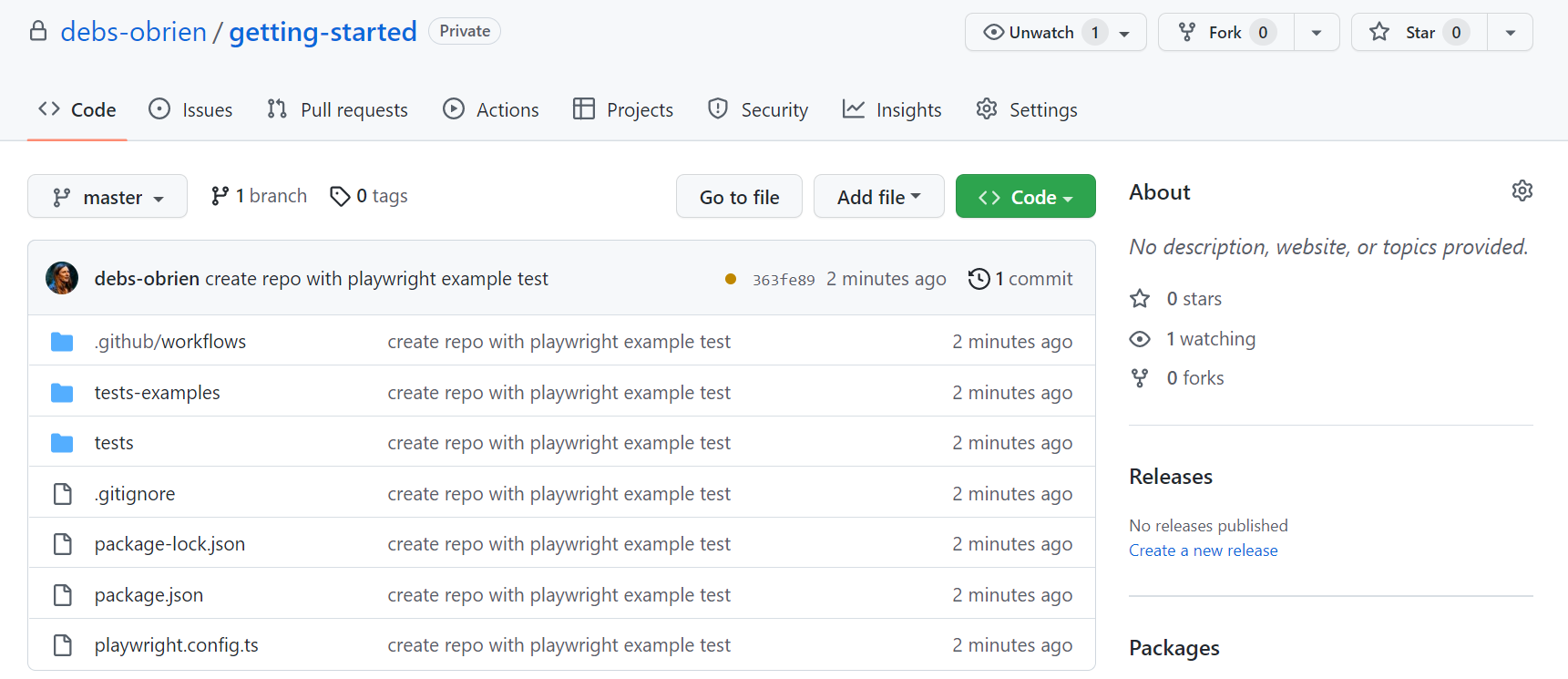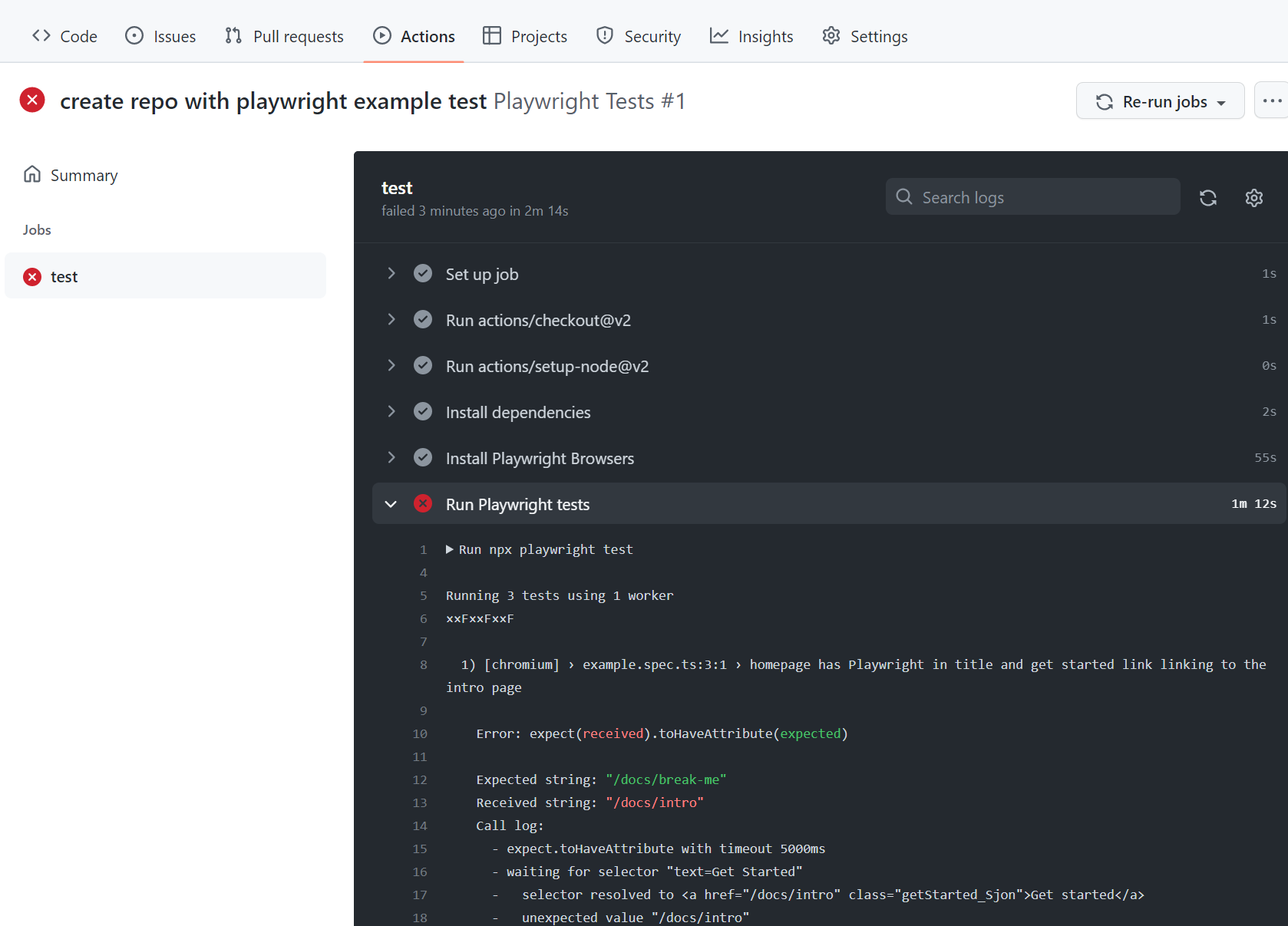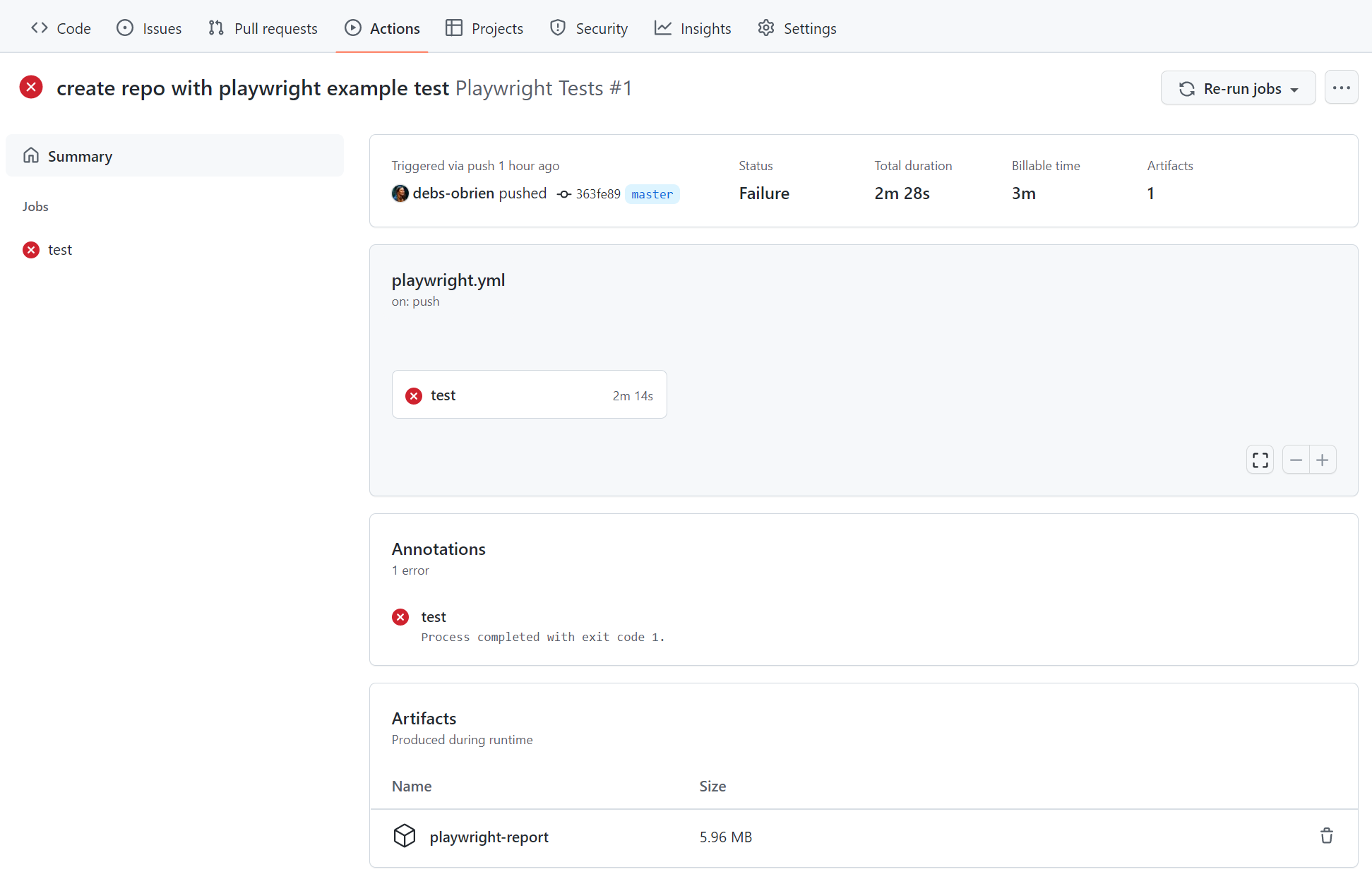| id | title |
|---|---|
ci-intro |
Setting up CI |
- langs: js
Playwright tests can be run on any CI provider. This guide covers one way of running tests on GitHub using GitHub actions. If you would like to learn more, or how to configure other CI providers, check out our detailed doc on Continuous Integration.
- langs: js
- How to set up GitHub Actions
- How to view test logs
- How to view the HTML report
- How to view the trace
- How to publish report on the web
- langs: python, java, csharp
Playwright tests can be ran on any CI provider. In this section we will cover running tests on GitHub using GitHub actions. If you would like to see how to configure other CI providers check out our detailed doc on Continuous Integration.
- langs: python, java, csharp
- langs: js
When installing Playwright using the VS Code extension or with npm init playwright@latest you are given the option to add a GitHub Actions workflow. This creates a playwright.yml file inside a .github/workflows folder containing everything you need so that your tests run on each push and pull request into the main/master branch. Here's how that file looks:
name: Playwright Tests
on:
push:
branches: [ main, master ]
pull_request:
branches: [ main, master ]
jobs:
test:
timeout-minutes: 60
runs-on: ubuntu-latest
steps:
- uses: actions/checkout@v4
- uses: actions/setup-node@v4
with:
node-version: lts/*
- name: Install dependencies
run: npm ci
- name: Install Playwright Browsers
run: npx playwright install --with-deps
- name: Run Playwright tests
run: npx playwright test
- uses: actions/upload-artifact@v4
if: ${{ !cancelled() }}
with:
name: playwright-report
path: playwright-report/
retention-days: 30The workflow performs these steps:
- Clone your repository
- Install Node.js
- Install NPM Dependencies
- Install Playwright Browsers
- Run Playwright tests
- Upload HTML report to the GitHub UI
To learn more about this, see "Understanding GitHub Actions".
- langs: python, java, csharp
To add a GitHub Actions file first create .github/workflows folder and inside it add a playwright.yml file containing the example code below so that your tests will run on each push and pull request for the main/master branch.
name: Playwright Tests
on:
push:
branches: [ main, master ]
pull_request:
branches: [ main, master ]
jobs:
test:
timeout-minutes: 60
runs-on: ubuntu-latest
steps:
- uses: actions/checkout@v4
- name: Set up Python
uses: actions/setup-python@v4
with:
python-version: '3.11'
- name: Install dependencies
run: |
python -m pip install --upgrade pip
pip install -r requirements.txt
- name: Ensure browsers are installed
run: python -m playwright install --with-deps
- name: Run your tests
run: pytest --tracing=retain-on-failure
- uses: actions/upload-artifact@v4
if: ${{ !cancelled() }}
with:
name: playwright-traces
path: test-results/name: Playwright Tests
on:
push:
branches: [ main, master ]
pull_request:
branches: [ main, master ]
jobs:
test:
timeout-minutes: 60
runs-on: ubuntu-latest
steps:
- uses: actions/checkout@v4
- uses: actions/setup-java@v3
with:
distribution: 'temurin'
java-version: '17'
- name: Build & Install
run: mvn -B install -D skipTests --no-transfer-progress
- name: Ensure browsers are installed
run: mvn exec:java -e -D exec.mainClass=com.microsoft.playwright.CLI -D exec.args="install --with-deps"
- name: Run tests
run: mvn testname: Playwright Tests
on:
push:
branches: [ main, master ]
pull_request:
branches: [ main, master ]
jobs:
test:
timeout-minutes: 60
runs-on: ubuntu-latest
steps:
- uses: actions/checkout@v4
- name: Setup dotnet
uses: actions/setup-dotnet@v4
with:
dotnet-version: 8.0.x
- name: Build & Install
run: dotnet build
- name: Ensure browsers are installed
run: pwsh bin/Debug/net8.0/playwright.ps1 install --with-deps
- name: Run your tests
run: dotnet testTo learn more about this, see "Understanding GitHub Actions".
Looking at the list of steps in jobs.test.steps, you can see that the workflow performs these steps:
- Clone your repository
- Install language dependencies
- Install project dependencies and build
- Install Playwright Browsers
- Run tests
Once you have your GitHub actions workflow setup then all you need to do is Create a repo on GitHub or push your code to an existing repository. Follow the instructions on GitHub and don't forget to initialize a git repository using the git init command so you can add, commit and push your code.
- langs: js, java, python
- langs: csharp
Click on the Actions tab to see the workflows. Here you will see if your tests have passed or failed.
- langs: js, python, java
- langs: csharp
On Pull Requests you can also click on the Details link in the PR status check.
Clicking on the workflow run will show you the all the actions that GitHub performed and clicking on Run Playwright tests will show the error messages, what was expected and what was received as well as the call log.
- langs: js, python, java
- langs: csharp
- langs: js
The HTML Report shows you a full report of your tests. You can filter the report by browsers, passed tests, failed tests, skipped tests and flaky tests.
- langs: js
In the Artifacts section click on the playwright-report to download your report in the format of a zip file.
- langs: js
Locally opening the report will not work as expected as you need a web server in order for everything to work correctly. First, extract the zip, preferably in a folder that already has Playwright installed. Using the command line change into the directory where the report is and use npx playwright show-report followed by the name of the extracted folder. This will serve up the report and enable you to view it in your browser.
npx playwright show-report name-of-my-extracted-playwright-reportTo learn more about reports check out our detailed guide on HTML Reporter
- langs: js
Once you have served the report using npx playwright show-report, click on the trace icon next to the test's file name as seen in the image above. You can then view the trace of your tests and inspect each action to try to find out why the tests are failing.
- langs: python, java
trace.playwright.dev is a statically hosted variant of the Trace Viewer. You can upload trace files using drag and drop.
- langs: csharp
You can upload Traces which get created on your CI like GitHub Actions as artifacts. This requires starting and stopping the trace. We recommend only recording traces for failing tests. Once your traces have been uploaded to CI, they can then be downloaded and opened using trace.playwright.dev, which is a statically hosted variant of the Trace Viewer. You can upload trace files using drag and drop.
- langs: csharp
- langs: js
Downloading the HTML report as a zip file is not very convenient. However, we can utilize Azure Storage's static websites hosting capabilities to easily and efficiently serve HTML reports on the Internet, requiring minimal configuration.
-
Create an Azure Storage account.
-
Enable Static website hosting for the storage account.
-
Create a Service Principal in Azure and grant it access to Azure Blob storage. Upon successful execution, the command will display the credentials which will be used in the next step.
az ad sp create-for-rbac --name "github-actions" --role "Storage Blob Data Contributor" --scopes /subscriptions/<SUBSCRIPTION_ID>/resourceGroups/<RESOURCE_GROUP_NAME>/providers/Microsoft.Storage/storageAccounts/<STORAGE_ACCOUNT_NAME>
-
Use the credentials from the previous step to set up encrypted secrets in your GitHub repository. Go to your repository's settings, under GitHub Actions secrets, and add the following secrets:
AZCOPY_SPA_APPLICATION_IDAZCOPY_SPA_CLIENT_SECRETAZCOPY_TENANT_ID
For a detailed guide on how to authorize a service principal using a client secret, refer to this Microsoft documentation.
-
Add a step that uploads the HTML report to Azure Storage.
... - name: Upload HTML report to Azure shell: bash run: | REPORT_DIR='run-${{ github.run_id }}-${{ github.run_attempt }}' azcopy cp --recursive "./playwright-report/*" "https://<STORAGE_ACCOUNT_NAME>.blob.core.windows.net/\$web/$REPORT_DIR" echo "::notice title=HTML report url::https://<STORAGE_ACCOUNT_NAME>.z1.web.core.windows.net/$REPORT_DIR/index.html" env: AZCOPY_AUTO_LOGIN_TYPE: SPN AZCOPY_SPA_APPLICATION_ID: '${{ secrets.AZCOPY_SPA_APPLICATION_ID }}' AZCOPY_SPA_CLIENT_SECRET: '${{ secrets.AZCOPY_SPA_CLIENT_SECRET }}' AZCOPY_TENANT_ID: '${{ secrets.AZCOPY_TENANT_ID }}'
The contents of the $web storage container can be accessed from a browser by using the public URL of the website.
:::note This step will not work for pull requests created from a forked repository because such workflow doesn't have access to the secrets. :::










